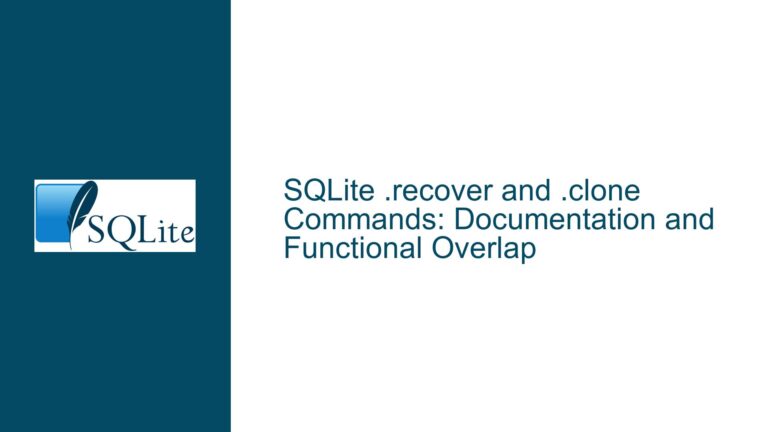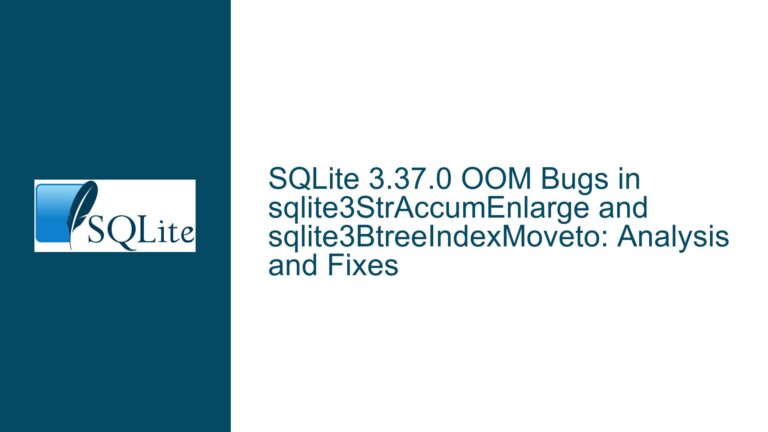Trigger Recreation Fails When Dropping and Recreating in SQLite via C API
Understanding SQLite’s Single-Statement Execution Model in C Programs
Issue Overview
A common scenario in SQLite development involves modifying database schema objects like triggers. Developers often attempt to replace an existing trigger by executing a compound SQL string containing a DROP TRIGGER followed by a CREATE TRIGGER statement, separated by a semicolon. When executed interactively through tools like DB Browser for SQLite, this approach works as expected: the old trigger is removed, and the new one is created. However, when the same SQL string is executed programmatically via the SQLite C API (specifically sqlite3_prepare_v2 and related functions), the new trigger is not created, leaving the database without the intended trigger. This discrepancy arises from a fundamental difference in how SQLite processes multi-statement strings in its C API versus interactive tools.
The root of the problem lies in SQLite’s statement preparation mechanism. The sqlite3_prepare_v2 function is designed to process one SQL statement at a time, even when presented with a string containing multiple statements separated by semicolons. When a multi-statement string is passed to sqlite3_prepare_v2, the function prepares only the first statement and returns a pointer to the remaining unprocessed SQL text via the pzTail parameter. If the caller does not explicitly process this remaining text, subsequent statements (like the CREATE TRIGGER command) are never executed. Interactive tools handle this internally by iterating through all statements in the input string, but C API users must implement this iteration manually.
Critical Analysis of SQL Statement Processing in C Programs
1. SQLite’s Prepare-Execute Cycle
The SQLite C API requires explicit handling of SQL execution through three phases:
- Preparation:
sqlite3_prepare_v2parses and compiles a single SQL statement into a bytecode program. - Execution:
sqlite3_stepruns the compiled bytecode. - Finalization:
sqlite3_finalizereleases resources associated with the prepared statement.
When presented with a multi-statement string like DROP TRIGGER ...; CREATE TRIGGER ...;, sqlite3_prepare_v2 only processes the first statement (DROP TRIGGER). The remaining SQL text (CREATE TRIGGER ...;) is left in pzTail and must be processed in subsequent calls to sqlite3_prepare_v2.
2. Common Misconceptions About Semicolon Separation
Many developers assume that semicolons in SQL strings act as universal statement separators in all execution contexts. While this is true for interactive shells and GUI tools, the C API delegates responsibility for multi-statement processing to the caller. Tools like DB Browser for SQLite implement logic to split input into individual statements and execute them sequentially. In custom C programs, this logic must be explicitly coded.
3. Resource Management Pitfalls
Improper handling of prepared statements can lead to resource leaks or dangling pointers. For example:
- Failing to call
sqlite3_finalizeon a prepared statement after execution leaks memory. - Reusing a statement pointer without resetting it (
sqlite3_reset) or finalizing it can cause undefined behavior. - Incorrectly assuming that
pzTailpoints to a copy of the remaining SQL text (it actually points to a position within the original input string).
Solutions for Reliable Trigger Recreation in C Programs
Step 1: Implement Multi-Statement Processing Logic
To execute all statements in a SQL string, use a loop that processes each statement sequentially:
const char *sql = "DROP TRIGGER IF EXISTS t_bi_prune_tst;"
"CREATE TRIGGER t_bi_prune_tst ... ;";
const char *zTail = sql;
sqlite3_stmt *stmt;
while (zTail && *zTail != '\0') {
int rc = sqlite3_prepare_v2(db, zTail, -1, &stmt, &zTail);
if (rc != SQLITE_OK) {
// Handle error
break;
}
rc = sqlite3_step(stmt);
if (rc != SQLITE_DONE && rc != SQLITE_ROW) {
// Handle error
}
sqlite3_finalize(stmt);
}
Step 2: Validate Input String Persistence
The pzTail parameter returned by sqlite3_prepare_v2 points to a position within the original SQL string. If the input string is modified or deallocated before processing completes, zTail will reference invalid memory. Ensure the SQL string remains valid throughout the processing loop.
Step 3: Error Handling and Debugging
- Check return codes: Validate the return value of
sqlite3_prepare_v2,sqlite3_step, andsqlite3_finalize. - Inspect
zTailcontents: After each iteration, log the remaining SQL text to verify that all statements are being processed. - Use
sqlite3_errmsg: Retrieve detailed error messages when operations fail.
Step 4: Transaction Management
Wrap schema changes in a transaction to ensure atomicity:
sqlite3_exec(db, "BEGIN TRANSACTION;", 0, 0, 0);
// Process DROP and CREATE statements
sqlite3_exec(db, "COMMIT;", 0, 0, 0);
This prevents the database from being left in an inconsistent state if an error occurs during processing.
Advanced Considerations for Production Environments
1. Parameterized Statements and Dynamic SQL
When constructing SQL strings dynamically (e.g., concatenating trigger names), use parameter binding to prevent SQL injection:
const char *triggerName = "t_bi_prune_tst";
char *dropSql = sqlite3_mprintf("DROP TRIGGER IF EXISTS %q;", triggerName);
char *createSql = "..."; // Similarly sanitize CREATE statement
2. Schema Versioning and Migration Scripts
For applications requiring frequent schema changes, implement a versioning system that tracks applied migrations. Store each migration as a separate SQL file and process them sequentially, ensuring that multi-statement scripts are handled correctly.
3. Testing Edge Cases
- Empty statements: SQL strings containing
;;(empty statements) will causesqlite3_prepare_v2to returnSQLITE_OKwith astmtofNULL. Handle this by skipping execution whenstmtisNULL. - Comments: SQL comments (e.g.,
-- ...or/* ... */) do not affect statement parsing, but ensure they don’t interfere withzTailpositioning.
Conclusion
The failure to recreate a trigger after dropping it in a C program stems from SQLite’s deliberate design choice to process one statement per sqlite3_prepare_v2 call. By implementing robust multi-statement processing loops, validating input persistence, and adhering to SQLite’s resource management rules, developers can reliably execute schema modification commands. Interactive tools abstract this complexity, but C API users must explicitly handle these low-level details to achieve consistent behavior.






